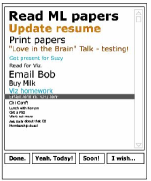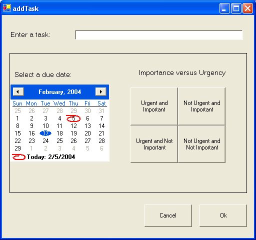 Task management tools that exist today are suboptimal for a variety of reasons (including task entry,
categorization, and in the ephemeral "actually helpful in getting things done" way). But fundamentally,
they fail because they don't know very much at all about the user. TaskMINDER was a class project for
Adaptive Personalised Information Environments (CS 8803B). Our intention was to build a task management
tool that could dynamically reorder itself based on the users location, activity and preferences.
Task management tools that exist today are suboptimal for a variety of reasons (including task entry,
categorization, and in the ephemeral "actually helpful in getting things done" way). But fundamentally,
they fail because they don't know very much at all about the user. TaskMINDER was a class project for
Adaptive Personalised Information Environments (CS 8803B). Our intention was to build a task management
tool that could dynamically reorder itself based on the users location, activity and preferences.
TaskMINDER used a a statistical learning model where it ranked the importance of task based on severa
factors such as location, feedback, etc... This statistical data was stored relative to the words that
that described as task. The data collected by TaskMINDER included:
Location detection using WiFi access points - TaskMINDER used the signal to noise ratios of the
nearby WiFi access points to determine its location relative to previous experience. We did not try to
name or in any way classify a location and instead used the base station ID (BSSID) of the access points
with the best signal to noise ration to detemine if the user had ever been to this location before

User feedback - TaskMINDERs' primary source of feedback and learning was the input it received
from the user. It used users feedback to rank tasks based on their importance, appropriateness to the
current context, available time, etc... In order to maximise the feedback and make it as useful as
possible we used a conversational model for user interaction as well as allowing users to give graded
feedback on the suggestions they were given (i.e. Great idea, soon, later, etc...)

Available time - An important feature of task minder was allowing users to order tasks based on
how much time the had available. Users could ask the system for "15 minute tasks", "5 minute tasks",
etc... TaskMINDER then used the user feedback from these ordered lists to classify tasks based on how
long they would probably take.
Activity monitoring - We attempted to classify a users activity by monitoring the applications
that the user was using that data to determine preferences.
Adding a Task
 Another important feature of the TaskMINDER UI was designing an interface that encouraged users to give
more infomation about a task without being excessively constraining. The only feature that the users
were required to fill in was the name of the task. Users could optionally add information about the task
deadline if any as well as the importance/urgency of the task. While these features were optional the
interface was so lightweight that most uers would use it if appropriate.
Another important feature of the TaskMINDER UI was designing an interface that encouraged users to give
more infomation about a task without being excessively constraining. The only feature that the users
were required to fill in was the name of the task. Users could optionally add information about the task
deadline if any as well as the importance/urgency of the task. While these features were optional the
interface was so lightweight that most uers would use it if appropriate.